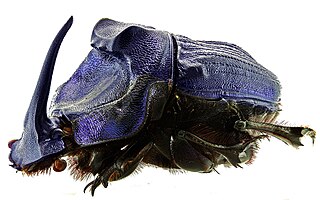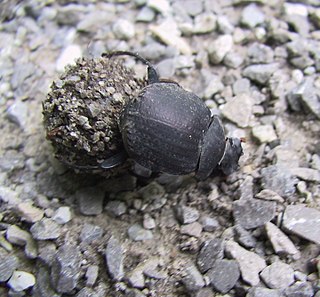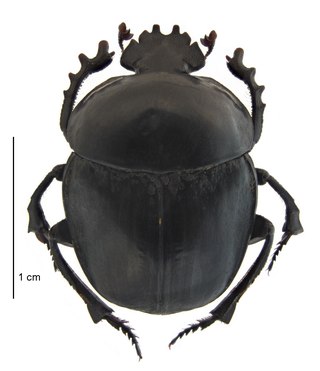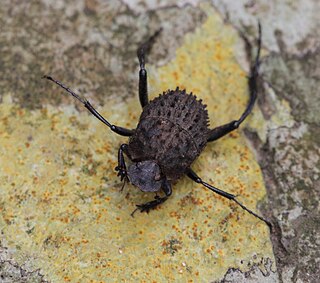
Beetles are insects that form the order Coleoptera, in the superorder Holometabola. Their front pair of wings are hardened into wing-cases, elytra, distinguishing them from most other insects. The Coleoptera, with about 400,000 described species, is the largest of all orders, constituting almost 40% of described insects and 25% of all known animal species; new species are discovered frequently, with estimates suggesting that there are between 0.9 and 2.1 million total species. Found in almost every habitat except the sea and the polar regions, they interact with their ecosystems in several ways: beetles often feed on plants and fungi, break down animal and plant debris, and eat other invertebrates. Some species are serious agricultural pests, such as the Colorado potato beetle, while others such as Coccinellidae eat aphids, scale insects, thrips, and other plant-sucking insects that damage crops.

Dung beetles are beetles that feed on feces. Some species of dung beetles can bury dung 250 times their own mass in one night.

Hydrophilidae, also known colloquially as water scavenger beetles, is a family of beetles. Aquatic hydrophilids are notable for their long maxillary palps, which are longer than their antennae. Several of the former subfamilies of Hydrophilidae have recently been removed and elevated to family rank; Epimetopidae, Georissidae, Helophoridae, Hydrochidae, and Spercheidae. While the majority of hydrophilids are aquatic, around a third of described species are terrestrial, mostly belonging to the subfamily Sphaeridiinae.

The scarab beetle subfamily Scarabaeinae consists of species collectively called true dung beetles. Most of the beetles of this subfamily feed exclusively on dung. However, some may feed on decomposing matter including carrion, decaying fruits and fungi. Dung beetles can be placed into three structural guilds based on their method of dung processing namely rollers (telecoprids), dwellers (endocoprids) and tunnelers (paracoprids). Dung removal and burial by dung beetles result in ecological benefits such as soil aeration and fertilization; improved nutrient cycling and uptake by plants, increase in Pasture quality, biological control of pest flies and intestinal parasites and secondary seed dispersal. Well-known members include the genera Scarabaeus and Sisyphus, and Phanaeus vindex.

Coprophanaeus is a genus in the family Scarabaeidae. The genus is almost entirely Neotropical, with a single species, C. pluto, ranging into southernmost Texas in the United States. They are medium-sized to large beetles, with the South American C. ensifer and C. lancifer sometimes exceeding 5 cm (2 in) in length, making these two some of the largest dung beetles in the world and the largest in the Americas. They often have a horn on the head, and are typically a bright metallic color, most often blue or green, or black. These diurnal or crepuscular beetles are excellent diggers and good fliers.

Deltochilum is a genus of true dung beetles in the family Scarabaeidae native to the Americas. There are more than 100 described species in Deltochilum. Unusually for a dung beetle, a few species in the genus, including D: valgum, are predators that kill and feed on millipedes.

Eurysternus is a genus of Scarabaeinae or dung beetles in the family Scarabaeidae. It is normally placed in the Oniticellini, although some authors consider it the single genus in the tribe Eurysternini (e.g.). It is restricted to the Neotropics and includes 53 recognized species.
Ontherus is a genus of Scarabaeidae or scarab beetles in the superfamily Scarabaeoidea.

Digitonthophagus gazella is a species of scarab beetle. It belongs to the genus Digitonthophagus, which was promoted from subgenus to genus level in 1959. There has been some confusion regarding the application of the names with many people using the outdated name Onthophagus gazella. Dung beetle experts use the term Digitonthophagus gazella.

Sceliages, Westwood,, is a sub-genus of the Scarabaeus dung beetles, and are obligate predators of spirostreptid, spirobolid and julid millipedes, having renounced the coprophagy for which they were named. The genus is near-endemic to Southern Africa, Sceliages augias exceptionally ranging as far north as the Democratic Republic of Congo.

Coprophanaeus ensifer is a large South American species of beetle belonging to the family Scarabaeidae.

Phanaeus, the rainbow scarabs, is a genus of true dung beetles in the family Scarabaeidae, ranging from the United States to northern Argentina, with the highest species richness in Mexico. Depending on species, they can inhabit a wide range of habitats, from tropical to temperate climates and deserts to rainforests. In those living in relatively arid places adults are primarily active during the wet season and those living in relatively cold places are primarily active during the summer. They are excellent diggers and good fliers.

Sulcophanaeus imperator is a brightly colored species of dung beetle belonging to the family Scarabaeidae. This diurnal, coprophagous beetle is native to south-central South America and generally common. It is paracoprid, meaning that adults dig tunnels into the soil under the food source and move parts of the food source to a nest chamber where the eggs are laid.

Oxysternon is a Neotropical genus of scarab beetles (Scarabaeidae) in the superfamily Scarabaeoidea. It can be distinguished from all other phanaeines and scarabaeine dung beetles by a long, spiniform extension of the anterior angle of the metasternum. Most species vary in color and pattern, and are more commonly found in tones of green, often infused with yellow or coppery highlights. All species appear very smooth or glassy smooth to the unaided eye.

Sisyphini is a tribe of scarab beetles, in the dung beetle subfamily (Scarabaeinae), but it may now be combined with the Scarabaeini. The middle and hind legs are very long; the relatively short body is laterally compressed and has flattened sides. Relative to other dung beetles they are of small to moderate size.

Phanaeini is a tribe of dung beetles in the family Scarabaeidae. There are about 12 genera and 200 described species in Phanaeini. They are native to the Americas with the highest species richness in the Neotropics. They are mostly coprophagous or necrophagous, but some of the least known genera appear to be myrmecophilous. They are medium-sized to large beetles, often with bright metallic colors, and often with horns on their heads.
Odontolytes is a genus of aphodiine dung beetles in the family Scarabaeidae. There are about 19 described species in Odontolytes.

Oxysternon conspicillatum is a species of dung beetle in the family Scarabaeidae. It is found in both evergreen and semi-deciduous mesic forests, including disturbed habitats, ranging from near sea level to an altitude of 3,000 m (9,800 ft) in the Amazon basin and Chocó of tropical South America and Panama, possibly extending as far west as the border region with Costa Rica. Both adults and young of this common and widespread beetle primarily feed on dung, but the species has also been recorded feeding on dead animals.

Caccobius unicornis, is a species of dung beetle found in many Asian and South East Asian countries such as: India, Sri Lanka, China, Java, Borneo, Taiwan, Korea, Japan, Myanmar, North Vietnam, Philippines, Sumatra, Java, Borneo, Malaysia, Thailand, and Indochina.

Coprophanaeus lancifer is a large species of beetle belonging to the family Scarabaeidae. It is found widely in the Amazon rainforest in South America and it is often common.
















